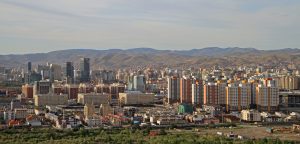As first-time visitors to Ulaanbaatar during winter, one of our first vivid experiences in the “world’s coldest capital” was the sudden thawing of the skin as one leaves the freezing outdoors and walks into overheated buildings. This paradox is just one of many that residents of Ulaanbaatar encounter on a daily basis.
The city’s exponential urban growth has fulfilled the promise of employment opportunities, higher education, and urban lifestyles for many migrants relocating from rural areas across Mongolia. Many Mongolians move to the capital in pursuit of economic opportunities – good jobs and competitive wages. Beyond these economic pull factors, potential migrants are drawn toward secondary benefits such as social infrastructure, safe living conditions, and leisure activities.
The spillover externalities of mass migration into the metropolis have created a harsh reality of dismal living conditions. Ulaanbaatar residents face increased respiratory illnesses from air pollution caused by high concentration of fine particles (PM 2.5), reaching 13 times higher than the World Health Organization’s annual quality assurance mark. Endless traffic snarls cost road users about 2.5 hours of their day, along with unsafe streets due to poor street lighting. There is rising income inequality in ger districts, and severe shortages in social infrastructure such as childcare services.
Mongolia is far from the only country experiencing overcrowding in urban centers. Similar patterns can be found in cities across Asia such as Dhaka and Seoul. Climate migration has also intensified migratory patterns toward urban centers as rural livelihoods are depleted, and urban centers continue to offer the promise of income and stability. But the draw of major cities creates the urban paradox, where overcrowding overwhelms existing physical and social infrastructure – and, as the COVID-19 pandemic showed, overcrowding also hampers efforts to reduce the spread of contagious diseases.
In Mongolia, stakeholders at different levels of government have proposed approaches to resolve the urban crisis, such as migration restrictions into Ulaanbaatar city; upgrades to public transit, parking spots, and public transport parks; and the Creating Investable Cities initiative by the Asian Development Bank. These supply-side policies have been hampered by implementation challenges given that Ulaanbaatar still hosts 45 percent of the city’s population (as of 2019), compared to just 26 percent in the 1990s.
Expanding employment opportunities in secondary cities through remote work might be a precursor toward an urban exodus from overcrowded Ulaanbaatar.
The International Organization for Migration (IOM) has begun work to scratch the surface of reverse migration as a policy solution in Mongolia. Conventional scholarship on reverse migration associates the phrase with expatriates returning from the diaspora to their home countries (international migration), but this same rationale is applicable in an internal/ domestic migration context, where there are sending and receiving regions within national borders.
Reverse migration in this local context entails incentivizing internal movement toward secondary cities or less urbanized regions in the country. This allows migrants to access more peaceful living conditions away from the harsh realities of overpopulation in the urban center, and accentuates economic growth in smaller urban centers with new streams of taxation and revenue from incoming migrants.
There are, however, certain barriers to reversing migration; the most difficult being the provision of economic incentives that can compete with those in urban hubs.
The pandemic-related shutdowns opened the world’s eyes to the possibilities of remote work. There has never before been the opportunity for decentralized work on such a large scale. This is a unique opportunity for countries to leverage the proven efficient and effective track-record of remote work to allow for migration to cities and smaller centers where offices and work sites may not yet be in place.
Across Asia, different cities have reaped the benefits of implementing remote work policies. Manila, capital of the Philippines, is pursuing remote work to ease traffic congestion from commuters. In South Korea, remote work led to National Smart Cities, which have effectively decentralized administrative functions and reduced the population density in Seoul. South Korea’s government further encouraged employees and employers to adopt teleworking approaches since the pandemic era through the 2020 Comprehensive Manual on Telework and funding worth 3.6 million won for companies that uphold remote work options.
The key to incentivizing reverse migration in a short time frame lies with remote work. There will be no immediate need for receiving cities to develop industry and labor intake capacity; that can come later. In Mongolia, secondary cities like Darkhan can manage the intake of reverse migrants by offering educational opportunities at all levels, social infrastructure, and cultural services. Increased remote work opportunities will allow individuals to pursue lifestyle migration, given their economic baseline needs are being met through decentralized work offerings. Consequently, these secondary cities are likely to flourish with newfound income from arriving migrants – as was the case in the French countryside with an increased remote working population.
Developing smaller, less urbanized regions with city plans that allow for rapid growth can facilitate reverse migration toward less crowded alternatives. Intentional growth in these regions can be customized based on local contexts. Reverse migration could be a local solution to overcrowding in cities – and remote work is a potential pathway to making it happen.
































